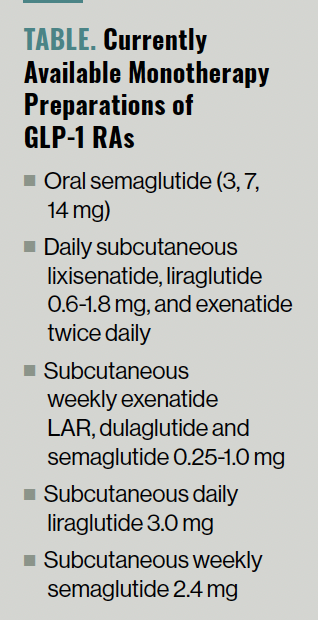Publication
Article
Psychiatric Times
Can Semaglutide Help in Psychiatry Too? Research Shows Promise for AD and PD
Available evidence from preclinical studies indicates that semaglutide shows promise for treating Alzheimer disease and Parkinson disease.
Naeblys/AdobeStock

Glucagon-like peptide-1 (GLP-1) is derived in the gut and belongs to the family of incretin hormones.1 GLP-1 has been found to intensify insulin secretion, suppress the release of glucagon, delay gastric emptying, and reduce insulin resistance.2 It also appears to promote physiological satiety via central and peripheral mechanisms. GLP-1 acts as a neurotransmitter in the central nervous system that signals satiety via the brain stem and the hypothalamic pathways. Additionally, GLP-1 reduces energy intake and regulates appetite by reducing hunger, increasing the sense of fullness, reducing food intake, and promoting satiety.
GLP-1 receptor agonists (GLP-1 RAs) are a group of drugs that were found to have the potential to treat diabetes mellitus (DM), without causing the adverse effects of hypoglycemia or weight gain.3 They were initially available as injectable therapies for the glycemic management of type 2 DM (T2DM).4 The GLP-1 RAs are now available in the oral formulation semaglutide. Currently available monotherapy preparations of GLP-1 RAs include those drugs indicated for T2DM (Table).
Table. Currently Available Monotherapy Preparations of GLP-1 RAs

Semaglutide is approved by the US Food and Drug Administration (FDA) for the treatment of T2DM via once-weekly subcutaneous injection doses of 0.25, 0.5, and 1 mg and once-daily oral doses of 3, 7, and 14 mg. It is also approved by the FDA for long-term weight management at subcutaneous doses of 1.7 and 2.4 mg once weekly.5
Looking for Novel Treatment
There has been an increased interest in using antidiabetic agents in the treatment of Alzheimer disease (AD) and Parkinson disease (PD) due to the identification of possible links between DM and the development of AD and PD.6-8 In an excellent review, Nowell et al examined the use of antidiabetic agents in the treatment of AD and PD.9 The authors discussed the possible mechanistic link between DM, AD, and PD, including inflammation, insulin resistance, and oxidative stress. They cited 16 studies of antidiabetic agents including 5 trials among individuals with AD, 3 trials among individuals with PD, 1 trial among individuals with mild cognitive impairment (MCI), 6 trials among individuals with MCI or AD, and 1 trial among individuals with subjective cognitive complaints. These studies included 6 trials of insulin, 2 trials of metformin, 3 trials of peroxisome proliferator–activated receptor γ agonist (2 for rosiglitazone and 1 for pioglitazone), and 5 trials of GLP-1 RAs (2 of liraglutide and 3 of exenatide). Similarly, there has also been recent interest in the use of semaglutide among individuals with AD and PD.10
Exploring Semaglutide for AD
Preclinical studies. Chang et al investigated the neuroprotective effects of semaglutide (0, 5, 10, 15 nmol/L) in the SH-SY5Y cell line treated by amyloid-β peptide (Aβ). They found semaglutide restored cell viability damaged by Aβ25-35 in the SH-SY5Y cell line and normalized the expression of autophagy-related proteins LC3II, Atg7, Beclin-1, and p62 inhibited by Aβ25-35 and of apoptosis-related proteins Bax and BCL-2 induced by Aβ25-35.11
Clinical studies. A recent study assessed exposure to GLP-1 RAs among individuals with T2DM and subsequent diagnosis of dementia using pooled data from 3 randomized, double-blind, placebo-controlled cardiovascular outcome trials (n = 15,820) and a nationwide Danish registry-based cohort (n = 120,054).12 The individual trials examined liraglutide (n = 9340), subcutaneous semaglutide (n = 3297), and oral semaglutide (n = 3183). The dementia rate was found to be lower among individuals who were randomized to GLP-1 RAs versus placebo in the 3 cardiovascular outcome trials (HR, 0.47) and in the nationwide cohort study (HR, 0.89), with yearly increased exposure to GLP-1 RAs.
Two phase 3 randomized controlled clinical trials of oral semaglutide versus placebo, EVOKE (NCT04777396) and EVOKE Plus (NCT04777409), are currently recruiting participants to investigate semaglutide’s efficacy in patients with early AD.13,14 In each trial, 1840 participants (aged 55 to 85 years) with mild cognitive impairment (MCI) due to AD [Clinical Dementia Rating (CDR) global = 0.5] or mild AD dementia (CDR global = 1.0) and who are amyloid positive will be randomized 1:1 to oral semaglutide 14 mg once daily (escalated via 3- and 7-mg doses over 8 weeks) or placebo for 156 weeks. Participants may use approved AD treatments during the trial if they are on a stable dose for at least 3 months before screening. The inclusion of at least 20% of participants with significant small vessel disease in the EVOKE Plus trial is the key difference between the 2 trials.14 The primary end point will be change in the CDR Sum of Boxes score from baseline to week 104. Confirmatory secondary end points will be change in Alzheimer’s Disease Cooperative Study-Activities of Daily Living-MCI score and time to progression to dementia among participants with MCI at baseline. After week 104, participants will continue their original randomized, double-blind, placebo-controlled treatment for a 52-week extension phase, followed by a 5-week follow-up, allowing assessment of the long-term effects of semaglutide. The readouts from the trials are expected in 2025.
Exploring Semaglutide for PD
Preclinical studies. Semaglutide has demonstrated benefit in a chronic 1-methyl-4-phenyl-1,2,3,6-tetrahydropyridine (MPTP) mouse model of PD. Zhang et al demonstrated that the use of semaglutide (25 nmol/kg, once daily for 7 days) improved MPTP-induced motor impairments, rescued the decrease of tyrosine hydroxylase (TH) levels, alleviated the inflammatory response, reduced lipid peroxidation, and inhibited the pathway for apoptosis in mice.15 The drug also increased autophagy-related protein expression to protect dopaminergic neurons in the substantia nigra and in the striatum of mice. The authors found that semaglutide was superior to liraglutide in most of the measures assessed.
In another study, Zhang et al found that semaglutide (25 nmol/kg, once every 2 days for 30 days) resulted in a number of positive outcomes. For instance, it improved MPTP-induced motor impairments, rescued the decreased TH levels, and reduced the accumulation of aggregated α-synuclein in mice.16 Additionally, the drug alleviated the chronic inflammatory response in the brain, reduced lipid peroxidation, and inhibited the mitochondrial mitophagy signaling pathway. Furthermore, semaglutide increased the expression of the germ cell-derived growth factor (GDNF) that protects the dopaminergic neurons in the substantia nigra and striatum. Semaglutide was again found to be superior to once-daily liraglutide in most of the results in this study.
In a third study, semaglutide and a dual GLP-1/glucose-dependent insulinotropic polypeptide RA (DA5-CH) that crosses the blood-brain barrier at a greater rate than semaglutide were tested in the 6-hydroxydopamine (6-OHDA)–lesion rat model of PD.17 The treatments included semaglutide or DA5-CH (25 nmol/kg) daily that were given daily for 30 days after lesion identification. The investigators found that both drugs reduced the apomorphine-induced rotational behavior. They also noted reduced dopamine depletion and the inflammatory response (reduced IL-1β) and tumor necrosis factor α [TNF-α] levels) in the lesioned striatum of the rats. In addition, both drugs protected dopaminergic neurons and increased TH expression in the substantia nigra. Furthermore, both the drugs reduced the level of monomer and aggregated α-synuclein and insulin resistance.
Liu et al evaluated the neuroprotective effects of semaglutide and liraglutide on human neuroblastoma SH-SY5Y cell line treated with 6-OHDA and found equivalent doses (10-nmol concentration) of semaglutide and liraglutide increased cell survival rate, enhanced autophagy, and reduced mitochondrial apoptosis, when compared with 6-OHDA alone.18 They further found that semaglutide provided greater neuroprotection to the cell line than did liraglutide.
Clinical studies. The Oslo University Hospital registered a phase 2 clinical study for exploring the effectiveness of semaglutide among individuals with PD.19 Over a 2-year period, this single-center, double-blind, placebo-controlled study plans to enroll 270 participants newly diagnosed with idiopathic PD. The enrolled participants will be randomized to receive once-weekly self-administered subcutaneous injections of semaglutide (1.0 mg) or placebo in a 1:1 study design for 24 months in a double-blind period 1 of the study. Then both groups will receive semaglutide for another 2 years in an open portion of the study.
The study will measure the effects of semaglutide on motor symptoms, cognitive function, and on nonmotor symptoms of PD. Assessments will be performed at baseline, after 12, 24, 36, and 48 months of the study. Blood and cerebrospinal samples will be taken to analyze inflammatory markers, and to confirm the penetration of semaglutide across the blood-brain barrier. The trial has yet to enroll participants despite a proposed start date of January 2, 2019, and study completion date of December 31, 2024.
Discussion
Available evidence from preclinical studies (1 for AD and 4 for PD) indicates that semaglutide shows promise for treating AD and PD.11,15-18 The drug appears to restore cell viability, enhance autophagy, and reduce apoptosis in the SH-SY5Y cell line treated by Aβ.11 In mouse models for PD, semaglutide improved MPTP-induced motor impairments, rescued the decrease of tyrosine hydroxylase (TH) levels, alleviated the inflammatory response, reduced lipid peroxidation, and inhibited the pathway for apoptosis in PD.15,16 The drug also increased autophagy-related protein expression that protects dopaminergic neurons in the substantia nigra and in the striatum of the mice, reducing the accumulation of aggregated α-synuclein.
Additionally, semaglutide appears to alleviate the chronic inflammatory response in the brain, reduce lipid peroxidation, inhibit the mitochondrial mitophagy signaling pathway, and increase the expression of GDNF that protects the dopaminergic neurons in the substantia nigra and striatum of mice. In rats, semaglutide reduced apomorphine-induced rotational behavior, dopamine depletion, and the inflammatory response (reduced IL-1β and TNF-α levels) in the lesioned striatum.17 Furthermore, the drug protected dopaminergic neurons and increased TH expression in the substantia nigra. Also, semaglutide reduced the level of monomer and aggregated α-synuclein and insulin resistance. Semaglutide increased cell survival rate, enhanced autophagy, and reduced mitochondrial apoptosis compared with 6-OHDA alone in the human neuroblastoma SH-SY5Y cell line.18 In these studies, semaglutide appeared to provide greater neuroprotection than liraglutide.
Alzheimer and Parkinson Disease Statistics

The data regarding the use of semaglutide among individuals with AD and PD from clinical studies are limited. Four trials (3 randomized control trials [RCTs] and 1 registry-based cohort study) of semaglutide indicated that the use of GLP-1 RAs among individuals with T2DM reduces dementia rates compared with placebo in cardiovascular outcome trials, with yearly increased exposure to GLP-1 RAs.17 The outcomes in these trials were all-cause dementia and not limited to AD. Additionally, in the 3 RCTs, dementia was not a prespecified end point, and there may have been an underreporting of dementia cases in 2 of the 3 RCTs, as these trials required only the reporting of serious adverse events. There are 2 large-scale phase 3 RCTs of semaglutide among individuals with early AD that are recruiting participants.13,14 Among individuals with PD, there are no completed clinical trials of semaglutide, but there is a pending phase 2 clinical trial (NCT03659682).19
GLP-1 RAs may reduce the incidence of AD and PD by various possible mechanisms.9 In addition to reducing the risk for neurodegeneration, GLP-1 RAs may reduce the cerebrovascular and cardiovascular risks for AD and PD. In the review by Nowell et al, the authors identified 5 studies of GLP-1 RAs (2 of liraglutide and 3 of exenatide) of individuals with AD and PD.9,20-24 The liraglutide studies were among individuals with AD and among individuals with subjective memory complaints, respectively.20,21 In both trials, liraglutide did not appear to confer any cognitive benefits compared with placebo. The exenatide trials included 1 study of individuals with AD and 2 studies of individuals with PD.22-24 The exenatide study of individuals with AD did not show any benefit for the drug when compared with placebo.22 One trial of exenatide showed benefits on cognition and motor symptoms among individuals with PD compared with controls.23 The second trial showed benefits in motor symptoms, but not for cognitive symptoms for exenatide when compared with placebo among individuals with PD.24 Both liraglutide and exenatide appeared to be well tolerated in these trials.
One meta-analysis that evaluated the effectiveness and safety of GLP-1 RAs for PD concluded that there is low-or-very low-certainty evidence indicating that exenatide may improve motor symptoms of PD, and these effects may persist for some time after the discontinuation of exenatide use.25 Another meta-analysis included data from 3 studies that indicated exenatide appears to improve cognition and motor and nonmotor symptoms among individuals with PD.26 As the preclinical data appear to indicate that semaglutide provides greater neuroprotection than liraglutide, hopefully this will translate into robust results in both AD and PD clinical trials of semaglutide.
Based on current evidence, the data regarding the use of semaglutide among individuals with AD and PD appear promising. However, data from multiple large high-quality controlled trials are needed before any conclusions can be drawn on whether semaglutide has a definitive role to play in the treatment of people with AD and PD.
Concluding Thoughts
Data from preclinical studies indicate that semaglutide may prevent neurodegeneration among cell lines representing AD and PD pathology. Available evidence indicates that semaglutide reduces all-cause dementia rates when compared with placebo.
Two large-scale RCTs are currently underway to evaluate semaglutide in individuals with early AD as well as a proposed study of semaglutide among individuals with PD. Although available data indicate that semaglutide may have some role to play in the treatment of AD and PD, evaluation of data from multiple controlled clinical trials is needed before this drug can be routinely used in the treatment of these important neurodegenerative disorders.
For more on type 2 diabetes mellitus, check out the Sidebar, "Efficacy Studies of Semaglutide for Type 2 Diabetes Mellitus."
Dr Joshi is a geriatric psychiatrist at Banner Alzheimer’s Institute and assistant clinical professor at University of Arizona College of Medicine-Phoenix. Dr Tampi is professor and chairman of the Department of Psychiatry at Creighton University School of Medicine and Catholic Health Initiatives Health Behavioral Health Services in Omaha, Nebraska. He is also an adjunct professor of psychiatry at Yale School of Medicine, New Haven, Connecticut.
References
1. Nauck MA, Quast DR, Wefers J, Meier JJ. GLP-1 receptor agonists in the treatment of type 2 diabetes - state-of-the-art. Mol Metab. 2021;46:101102.
2. Eliaschewitz FG, Canani LH. Advances in GLP-1 treatment: focus on oral semaglutide. Diabetol Metab Syndr. 2021;13(1):99.
3. Sharma D, Verma S, Vaidya S, et al. Recent updates on GLP-1 agonists: current advancements & challenges. Biomed Pharmacother. 2018;108:952-962.
4. Kalra S, Bhattacharya S, Kapoor N. Contemporary classification of glucagon-like peptide 1 receptor agonists (GLP1RAs). Diabetes Ther. 2021;12(8):2133-2147.
5. Ghusn W, De la Rosa A, Sacoto D, et al. Weight loss outcomes associated with semaglutide treatment for patients with overweight or obesity. JAMA Netw Open. 2022;5(9):e2231982.
6. Cardoso S, Moreira PI. Antidiabetic drugs for Alzheimer’s and Parkinson’s diseases: repurposing insulin, metformin, and thiazolidinediones. Int Rev Neurobiol. 2020;155:37-64.
7. Klimova B, Kuca K, Maresova P. Global view on Alzheimer’s disease and diabetes mellitus: threats, risks and treatment Alzheimer’s disease and diabetes mellitus. Curr Alzheimer Res. 2018;15(14):1277-1282.
8. Yue X, Li H, Yan H, et al. Risk of Parkinson disease in diabetes mellitus: an updated meta-analysis of population-based cohort studies. Medicine (Baltimore). 2016;95(18):e3549.
9. Nowell J, Blunt E, Gupta D, Edison P. Antidiabetic agents as a novel treatment for Alzheimer’s and Parkinson’s disease. Ageing Res Rev. 2023;89:101979.
10. Mahapatra MK, Karuppasamy M, Sahoo BM. Therapeutic potential of semaglutide, a newer GLP-1 receptor agonist, in abating obesity, non-alcoholic steatohepatitis and neurodegenerative diseases: a narrative review. Pharm Res. 2022;39(6):1233-1248.
11. Chang YF, Zhang D, Hu WM, et al. Semaglutide-mediated protection against Aβ correlated with enhancement of autophagy and inhibition of apoptosis. J Clin Neurosci. 2020;81:234-239.
12. Nørgaard CH, Friedrich S, Hansen CT, et al. Treatment with glucagon-like peptide-1 receptor agonists and incidence of dementia: data from pooled double-blind randomized controlled trials and nationwide disease and prescription registers. Alzheimers Dement (N Y). 2022;8(1):e12268.
13. A research study investigating semaglutide in people with early Alzheimer’s disease (EVOKE). ClinicalTrials.gov. Updated December 26, 2023. Accessed January 4, 2024. https://classic.clinicaltrials.gov/ct2/show/NCT04777396
14. A research study investigating semaglutide in people with early Alzheimer’s disease (EVOKE Plus). ClinicalTrials.gov. Updated December 26, 2023. Accessed January 4, 2024. https://classic.clinicaltrials.gov/ct2/show/NCT04777409
15. Zhang L, Zhang L, Li L, Hölscher C. Neuroprotective effects of the novel GLP-1 long acting analogue semaglutide in the MPTP Parkinson’s disease mouse model. Neuropeptides. 2018;71:70-80.
16. Zhang L, Zhang L, Li L, Hölscher C. Semaglutide is neuroprotective and reduces α-synuclein levels in the chronic MPTP mouse model of Parkinson’s disease. J Parkinsons Dis. 2019;9(1):157-171.
17. Zhang L, Li C, Zhang Z, et al. DA5-CH and semaglutide protect against neurodegeneration and reduce α-synuclein levels in the 6-OHDA Parkinson’s disease rat model. Parkinsons Dis. 2022;2022:1428817.
18. Liu DX, Zhao CS, Wei XN, et al. Semaglutide protects against 6-OHDA toxicity by enhancing autophagy and inhibiting oxidative stress. Parkinsons Dis. 2022;2022:6813017.
19. GLP1R in Parkinson’s disease (GIPD). ClinicalTrials.gov. Updated September 6, 2018. Accessed January 4, 2024. https://clinicaltrials.gov/ct2/show/NCT03659682
20. Gejl M, Gjedde A, Egefjord L, et al. In Alzheimer’s disease, 6-month treatment with GLP-1 analog prevents decline of brain glucose metabolism: randomized, placebo-controlled, double-blind clinical trial. Front Aging Neurosci. 2016;8:108.
21. Watson KT, Wroolie TE, Tong G, et al. Neural correlates of liraglutide effects in persons at risk for Alzheimer’s disease. Behav Brain Res. 2019;356:271-278.
22. Mullins RJ, Mustapic M, Chia CW, et al. A pilot study of exenatide actions in Alzheimer’s disease. Curr Alzheimer Res. 2019;16(8):741-752.
23. Aviles-Olmos I, Dickson J, Kefalopoulou Z, et al. Exenatide and the treatment of patients with Parkinson’s disease. J Clin Invest. 2013;123(6):2730-2736.
24. Athauda D, Maclagan K, Skene SS, et al. Exenatide once weekly versus placebo in Parkinson’s disease: a randomised, double-blind, placebo-controlled trial. Lancet. 2017;390(10103):1664-1675.
25. Mulvaney CA, Duarte GS, Handley J, et al. GLP-1 receptor agonists for Parkinson’s disease. Cochrane Database Syst Rev. 2020;7(7):CD012990.
26. Wang SY, Wu SL, Chen TC, Chuang CS. Antidiabetic agents for treatment of Parkinson’s disease: a meta-analysis. Int J Environ Res Public Health. 2020;17(13):4805.

Newsletter
Receive trusted psychiatric news, expert analysis, and clinical insights — subscribe today to support your practice and your patients.






